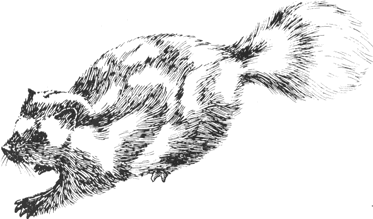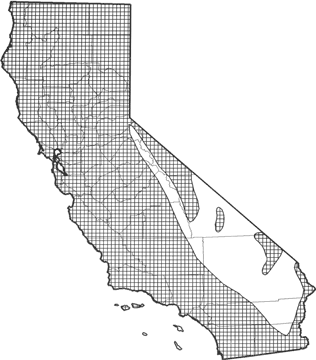
Western Spotted Skunk
Distribution, Abundance, and Seasonality
Common to uncommon, permanent resident in most habitats, except high mountains and those that are very dry, such as the Mojave and Colorado deserts (Grinnell et al. 1937). Occurs in shrub and brush habitats with moderate canopy-closure. Also inhabits open forest and woodland with scattered openings, and riparian habitats.

Range Map
Specific Habitat Requirements
Feeding: Spotted skunks are omnivorous. Diet is primarily insects and small mammals, along with reptiles, birds, eggs, carrion, fruits, and grains. Forage on ground, dig in earth, occasionally climb into low trees and shrubs, and may forage in shallow water.
Cover: Brushy areas, brush piles, slash, rock areas, burrows, and hollow logs, snags, and stumps are used for cover.
Reproduction: Nest in cavities, burrows, and natural crevices; in trees, snags, logs, stumps, in rock areas, brush piles, and under buildings.
Water: Little information available. These skunks can live in dry areas, but may require drinking water. Lactating females in captivity drank daily.
Pattern: Spotted skunks require a diverse interspersion of cover in moderately open shrub and open forest habitats, with riparian and herbaceous inclusions. Tree/shrub and shrub/herbaceous edges are frequented. Logs, stumps, slash, other woody debris, and cavities and crevices of all sorts enhance habitat for foraging and denning.
Species Life History
Activity Patterns: Mostly nocturnal and crepuscular; some diurnal activity. May remain in den for several days at a time in winter.
Seasonal Movements / Migration: Non-migratory.
Home Range: In lowa, Crabb (1948) found home ranges of males to average 518-1036 ha (1280-2560 ac) during spring and summer. Home ranges of males and females were similar during winter, averaging only 65 ha (160 ac). Individuals seldom traveled further than 0.4 km (0.2 mi) from the central den during winter. Crabb (1948) estimated a population of 5/km? (13/mi?).
Territory: Probably not territorial (Crabb 1948).
Reproduction: Mate in September and October. Gestation 210-230 days, including delayed implantation. Embryos implant 28-31 days prior to birth. One litter yr (average = 4 young, range = 2-6); most born in April and May (Mead 1968, Maser et al. 1981). Young weaned at about 8 wk., and young accompany female on foraging trips into autumn. Males and females mature sexually at 1 yr.
Niche: Domestic dogs, great horned owls, are humans appear to be the primary predators. Spotted skunks consume large numbers of insects and small mammals. An important carrier of rabies. May compete for food and space with long-tailed weasels, minks, ringtails, raccoons, and gray foxes.
Sources & References
California Department of Fish and Game, 1999.
California's Wildlife, Sacramento, CA.
Written by: G. Ahlborn, reviewed by: M. White, edited by: M. White, G. Ahlborn
Burt, W. H., and R. P. Grossenheider. 1976. A field guide to the mammals. 3d ed. Houghton Mifflin Co, Boston, MA. 289pp. Crabb, W. D. 1948. The ecology and management of the prairie spotted skunk in Iowa. Ecol. Monogr. 18:201-232. Grinnell, J., J. S. Dixon, and J. M. Linsdale. 1937. Fur-bearing mammals of California. 2 Vols. Univ. California Press, Berkeley. 777pp. Haley, D. 1975. Sleek and savage: North America's weasel family. Pacific Search Books, Seattle, WA. 128pp. Ingles, L. G. 1965. Mammals of the Pacific states. Stanford Univ. Press, Stanford, CA. 506pp. Maser, C., B. R. Mate, J. F. Franklin, and C. T. Dyrness. 1981. Natural history of Oregon coast mammals. Pac. Northwest For. And Range Exp. Sta., USDA, For. Serv., Gen. Tech. Rep., PNW-133. 496pp. Mead, R. A. 1968. Reproduction in western forms of the spotted skunk (Genus Spilogale). J. Mammal. 49:373-390. Williams, D. F. 1986. Mammalian species of special concern in California. Calif. Dept. Fish and Game, Sacramento. Admin. Rep. 86-1. 112pp.
California Animal Facts | California's Wildlife